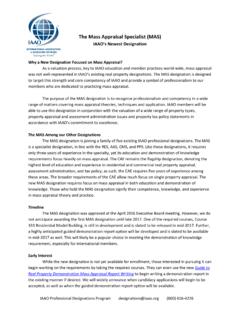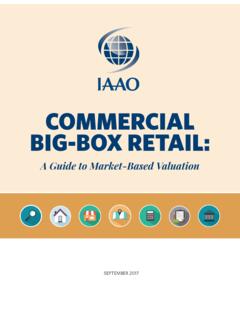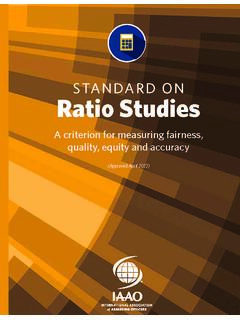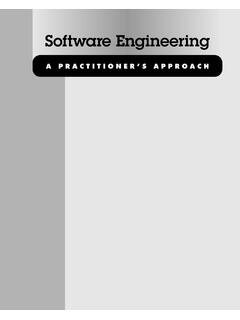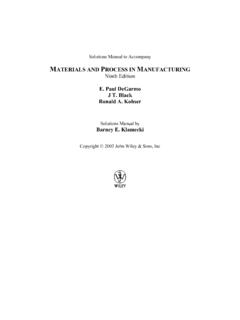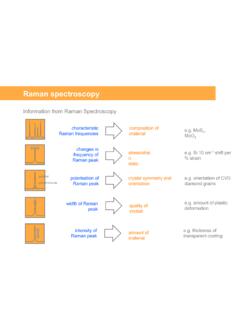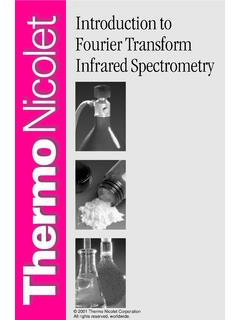Transcription of Standard on - IAAO
1 3 Standard on Mass Appraisal of Real Property Approved July 2017 International Association of Assessing Officers This Standard replaces the January 2012 Standard on Mass Appraisal of Real Property and is a complete revision. The 2012 Standard on Mass Appraisal of Real Property was a partial revision that replaced the 2002 Standard . The 2002 Standard combined and replaced the 1983 Standard on the Application of the Three Approaches to Value in Mass Appraisal, the 1984 Standard on Mass Appraisal, and the 1988 Standard on Urban Land Valuation. IAAO assessment standards represent a consensus in the assessing profession and have been adopted by the Executive Board of IAAO.
2 The objective of IAAO standards is to provide a systematic means by which concerned assessing officers can improve and standardize the operation of their offices. IAAO standards are advisory in nature and the use of, or compliance with, such standards is purely voluntary. If any portion of these standards is found to be in conflict with the Uniform Standards of Professional Appraisal Practice (USPAP) or state laws, USPAP and state laws shall govern. Published by International Association of Assessing Officers 314 W 10th St Kansas City, MO 64105-1616 phone: fax: toll-free: web site: ISBN 978-0-88329-2075 Copyright 2017 by the International Association of Assessing Officers All rights reserved.
3 No part of this publication may be reproduced in any form, in an electronic retrieval system or otherwise, without the prior written of the publisher. However, assessors wishing to use this Standard for educating legislators and policy-makers may photocopy it for limited distribution. 4 Contents 1. 2. 3. Collecting and Maintaining Property Geographic Property Characteristics Selection of Property Characteristics Data Initial Data Data Collection Data Collection Data Accuracy Data Collection Quality Data Maintaining Property Characteristics Alternative to Periodic On-Site Sales Income and Expense Cost and Depreciation Valuation The Cost The Sales Comparison The Income Land.
4 9 Considerations by Property Single-Family Residential ..9 Manufactured 4. Multifamily Residential Commercial and Industrial Nonagricultural Agricultural Special-Purpose Value Frequency of 5. Model Testing, Quality Assurance, and Value Model Sales Ratio Assessment Assessment Holdout Value 6. Managerial and Space Staffing and Space Data Processing Custom Generic Contracting for Appraisal Benefit-Cost Policy Administrative 7. Reference Standards of Professional Suggested 5 Standard ON MASS APPRAISAL OF REAL PROPERTY 2017 Standard on Mass Appraisal of Real Property 1.
5 Scope This Standard defines requirements for the mass appraisal of real property. The primary focus is on mass appraisal for ad valorem tax purposes. However, the principles defined here should also be relevant to CAMAs (CAMAs) (or automated valuation models) used for other purposes, such as mortgage portfolio management. The Standard primarily addresses the needs of the assessor, assessment oversight agencies, and taxpayers. This Standard addresses mass appraisal procedures by which the fee simple interest in property can be appraised at market value, including mass appraisal application of the three traditional approaches to value (cost, sales comparison, and income).
6 Single-property appraisals, partial interest appraisals, and appraisals made on an other-than-market-value basis are outside the scope of this Standard . Nor does this Standard provide guidance on determining assessed values that differ from market value because of statutory constraints such as use value, classification, or assessment increase limitations. Mass appraisal requires complete and accurate data, effective valuation models, and proper management of resources. Section 2 introduces mass appraisal. Section 3 focuses on the collection and maintenance of property data.
7 Section 4 summarizes the primary considerations in valuation methods, including the role of the three approaches to value in the mass appraisal of various types of property. Section 5 addresses model testing and quality assurance. Section 6 discusses certain managerial considerations: staff levels, data processing support, contracting for reappraisals, benefit-cost issues, and space requirements. Section 7 discusses reference materials. 2. Introduction Market value for assessment purposes is generally determined through the application of mass appraisal techniques.
8 Mass appraisal is the process of valuing a group of properties as of a given date and using common data, standardized methods, and statistical testing. To determine a parcel s value, assessing officers must rely upon valuation equations, tables, and schedules developed through mathematical analysis of market data. Values for individual parcels should not be based solely on the sale price of a property; rather, valuation schedules and models should be consistently applied to property data that are correct, complete, and up-to-date.
9 Properly administered, the development, construction, and use of a CAMA system results in a valuation system characterized by accuracy, uniformity, equity, reliability, and low per-parcel costs. Except for unique properties, individual analyses and appraisals of properties are not practical for ad valorem tax purposes. 3. Collecting and Maintaining Property Data The accuracy of values depends first and foremost on the completeness and accuracy of property characteristics and market data. Assessors will want to ensure that their CAMA systems provide for the collection and maintenance of relevant land, improvement, and location features.
10 These data must also be accurately and consistently collected. The CAMA system must also provide for the storage and processing of relevant sales, cost, and income and expense data. Overview Uniform and accurate valuation of property requires correct, complete, and up-to-date property data. Assessing offices must establish effective procedures for collecting and maintaining property data ( , property ownership, location, size, use, physical characteristics, sales price, rents, costs, and operating expenses). Such data are also used for performance audits, defense of appeals, public relations, and management information.

